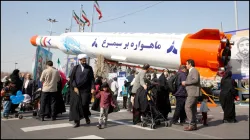Iran successfully sends 'Chamran-1' satellite into space, sparks Western concerns
Iran's Chamran-1 satellite, weighing 60 kg, reached a 550-km orbit in space aboard the Qaem-100 satellite carrier. Western countries, including the US, have long accused Tehran of using satellites to advance its nuclear missiles programme.

Tehran: Iran on Saturday said it has sent a research satellite into orbit with a rocket built by the paramilitary Revolutionary Guard, ignoring criticism from Western countries over the space project they say helps Tehran advance its nuclear programme. The Chamran-1 satellite reached a 550-km orbit in space aboard the Qaem-100 satellite carrier, according to IRNA news agency.
The spacecraft, which has been developed by several Iranian companies and industrial groups, weighs about 60 kg, said IRNA. Its main mission is to test hardware and software systems in order to prove orbital manoeuvring technology in height and phase. The launch comes amid heightened tensions gripping the wider West Asia over the ongoing Israel-Hamas war in the Gaza Strip.
The US State Department and the American military did not immediately respond to requests for comment over the Iranian launch. Washington previously said Iran's satellite launches defy a UN Security Council resolution and called on Tehran to undertake no activity involving ballistic missiles capable of delivering nuclear weapons.
In January, Iran claimed to have successfully launched three satellites into space with a rocket. The US military claims that the ballistic technology employed to send satellites into space could also be used to launch long-range weapons. However, Iran has always denied seeking nuclear weapons and says its space programme, like its nuclear activities, is for purely civilian purposes.
US concerns over Iran's satellite launch
UN sanctions related to Iran's ballistic missile programme expired last October. Under Iran's relatively moderate former President Hassan Rouhani, the Islamic Republic slowed its space programme for fear of raising tensions with the West. Hard-line President Ebrahim Raisi, a protege of Supreme Leader Ayatollah Ali Khamenei who came to power in 2021, has pushed the programme forward. Raisi died in a helicopter crash in May.
There have been five failed launches in a row for Iran's Simorgh program, a satellite-carrying rocket. The Simorgh, or “Phoenix,” rocket failures have been part of a series of setbacks in recent years for Iran’s civilian space program, including fatal fires and a launchpad rocket explosion that drew the attention of former US President Donald Trump.
US intelligence agencies and the IAEA say Iran had an organized military nuclear programme up until 2003. It's unclear what Iran's new president, the reformist Masoud Pezeshkian, wants for the programme as he was silent on the issue while campaigning. The US intelligence community's worldwide threat assessment this year said Iran's development of satellite launch vehicles “would shorten the timeline” for Iran to develop an intercontinental ballistic missile because it uses similar technology.
Intercontinental ballistic missiles can be used to deliver nuclear weapons. Iran is now producing uranium close to weapons-grade levels after the collapse of its nuclear deal with world powers. Tehran has enough enriched uranium for “several” nuclear weapons, if it chooses to produce them, the head of the International Atomic Energy Agency repeatedly has warned.
(with AP inputs)
ALSO READ | US diplomatic facility attacked in Baghdad 'to disrupt Iranian President Pezeshkian first visit to Iraq'